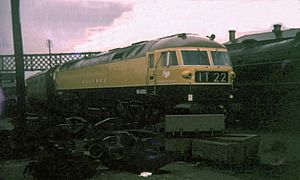British Rail HS4000 facts for kids
Quick facts for kids HS4000 "Kestrel" |
|
 |
|
| HS4000 outside Derby Locomotive Works, 1968-08-31. | |
| Power type | Diesel-electric |
|---|---|
| Builder | Hawker Siddeley, at Brush Traction, Loughborough |
| Serial number | Brush 711 |
| Build date | 1968 |
| UIC classification | Co'Co' |
| Gauge | 4 ft 8 1⁄2 in (1,435 mm) |
| Wheel diameter | 3 ft 9 in (1.143 m) |
| Wheelbase | 51 ft 8 in (15.75 m) |
| Length | 66 ft 6 in (20.27 m) |
| Width | 8 ft 9+3⁄4 in (2.69 m) |
| Height | 12 ft 9+3⁄4 in (3.91 m) |
| Locomotive weight | 133 long tons (135 t) |
| Fuel capacity | 1,000 imp gal (4,500 L; 1,200 US gal) |
| Prime mover | Sulzer 16LVA24 |
| Traction motors | Brush, 6 off |
| Transmission | AC alternator, DC traction motors |
| Top speed | 125 mph (201 km/h) |
| Power output | Engine: 4,000 hp (2,983 kW) At rail: 3,412 hp (2,544 kW) |
| Tractive effort | 70,000 lbf (311.38 kN) |
| Train brakes | Dual (Air and Vacuum) |
| Career | British Railways, Soviet Railways |
| Disposition | Exported to Russia, later scrapped. |
HS4000, named Kestrel, was a very powerful prototype diesel train engine. It was built in 1968 by a company called Brush Traction. They wanted to show British Railways how good their engines were. The name Kestrel came from Hawker Siddeley, which owned Brush. The "4000" part came from its amazing 4000 horsepower engine!
Contents
Meet Kestrel: A Super-Powerful Train Engine
Kestrel was a special kind of train engine called a diesel-electric locomotive. This means it used a diesel engine to power a generator. This generator then made electricity for the motors that turned the wheels. It was like having a power plant on wheels!
What Made Kestrel So Special?
- Huge Power: Kestrel had a massive Sulzer 16LVA24 engine. This engine could produce an incredible 4000 horsepower! That's a lot of power, like having many cars working together.
- High Speed: It was designed to be very fast. Kestrel could reach speeds of up to 125 miles per hour (201 km/h). This was super quick for a train engine back in the 1960s.
- Heavy Duty: The engine was also very heavy, weighing about 133 long tons (135 tonnes). This weight helped it pull long, heavy trains.
- Advanced Design: Kestrel was built to test new ideas and technologies for train engines. It was a "prototype," meaning it was the first of its kind.
Why Was Kestrel Built?
Brush Traction built Kestrel to show off their skills. They wanted to prove they could build powerful and reliable train engines. Their main goal was to impress British Railways, hoping they would order more engines like Kestrel.
Testing on British Railways
After it was built, Kestrel spent time being tested on the railway lines in Britain. Engineers watched how it performed. They checked its speed, power, and how well it handled different types of trains. It showed great promise and proved to be a very capable engine.
Kestrel's Journey to Russia
Even though Kestrel was built for British railways, it ended up having an unexpected adventure. In 1971, the Soviet Union (now Russia) became interested in its powerful design. They were looking for strong diesel engines for their own railway network.
A New Home and Gauge
The Soviet Union bought Kestrel for testing. Before it could run on their tracks, it needed some changes. Russian railways use a wider track width, called a track gauge, than British railways. So, Kestrel had its wheels adjusted to fit the new, wider gauge. It was then sent to the Soviet Union to continue its tests.
What Happened to Kestrel?
Kestrel was tested extensively in the Soviet Union. It helped engineers there learn more about high-powered diesel-electric locomotives. However, it was eventually decided not to build more engines like Kestrel in Russia. Sadly, after its testing was complete, Kestrel was eventually taken apart, or "scrapped." Even though it no longer exists, its story shows how one special train engine helped advance railway technology around the world.

